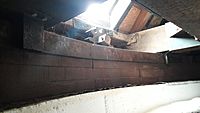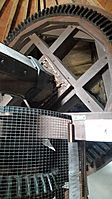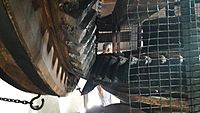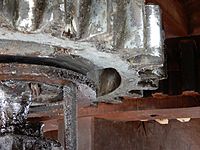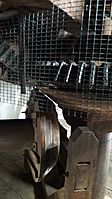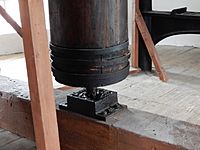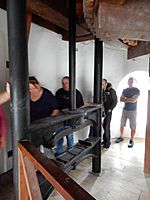Blennerville Windmill facts for kids
Quick facts for kids Blennerville Windmill |
|
|---|---|

Blennerville Windmill
|
|
| Origin | |
| Mill location | Blennerville, County Kerry |
| Coordinates | 52°15′24″N 9°44′15″W / 52.2567°N 9.7374°W |
| Year built | 1800 |
| Information | |
| Purpose | Corn mill |
| Type | Tower mill |
| Storeys | Five storeys |
| No. of sails | Four |
| Type of sails | Common sails |
The Blennerville Windmill is a tall, stone windmill located in Blennerville, County Kerry, Ireland. It stands about 21 meters (70 feet) high. This amazing mill has five levels inside, including a ground floor, a grinding floor, and a top cap floor. It's a famous landmark and a great place to learn about history.
Contents
History of Blennerville Windmill
Building the Mill
The Blennerville Windmill was built in the year 1800. It was ordered by Sir Rowland Blennerhassett. This mill was very important for grinding grain. It helped local people and also prepared grain to be sent to Great Britain.
How the Mill Worked
The mill had two sets of grinding stones. These special stones were made from French "bir" stone. A large wheel with wooden teeth turned a smaller gear. This gear then spun the grinding stones, crushing the grain into flour.
Why the Mill Stopped Working
Towards the end of the 1800s, the windmill started to fall apart. This happened for a few reasons:
- New steam engines became popular. They could grind grain faster.
- The river channel to Blennerville became too salty.
- A new shipping canal opened in Tralee in 1846.
- A new harbor was built in Fenit in 1880.
These changes meant ships could no longer easily reach Blennerville.
Bringing the Mill Back to Life
In 1981, the Tralee Urban District Council bought the old mill. They started a big project to fix it up in June 1984. The restored mill was officially opened in 1990. The Taoiseach (Prime Minister) at the time, Charles Haughey, was there for the opening. Today, the mill grinds wheat again, just like it did long ago. It is the only commercial windmill in Ireland that still works.
How the Windmill Works
Key Parts of the Mill
- Windshaft: This is a strong wooden shaft that weighs one ton. It connects the sails to the gears inside.
- Wings (Sails): The mill has four large wings, each about 18 meters (60 feet) long. They catch the wind and turn the windshaft.
- Crown Wheel: This wheel has special iron teeth that help transfer power.
- Brake: A wooden brake uses friction to stop the mill from turning when needed.
Turning the Mill to Face the Wind
The mill has a special system to turn its top part. This allows the sails to always face the wind. A chain is used outside the mill to slowly turn the top. It takes about two hours to turn the mill 180 degrees!
Lifting Sacks of Grain
The mill also has a "sack hoist." This is a clever system with a conical wheel. It helps lift heavy sacks of grain up to the grinding floor.
Visitor Centre
Today, the Blennerville Windmill is more than just a working mill. It also has a visitor centre. Here you can find:
- A craft centre with local goods.
- Model railways to explore.
- An art gallery.
- An audio-visual show about the mill's history.
- A restaurant.
You can also take a guided tour inside the mill. A guide will explain how everything works and share interesting stories.
Gallery



